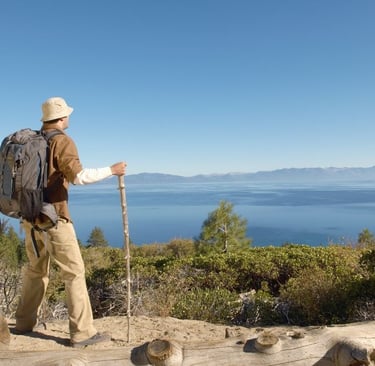Guide to the Portuguese Coastal Way
Discover a comprehensive guide to the Portuguese Coastal Way, with details on its history, planning, and what to expect in the Portuguese and Galician regions.


The Camino Portugués por la Costa is one of the most beautiful and accessible routes of the Camino de Santiago. With its combination of history, stunning landscapes, and rich cultural heritage, this route attracts thousands of pilgrims each year. Below is a complete guide covering the history, planning, and details of the Portuguese and Galician regions.
Planning the Camino Portugués por la Costa
Duration and Stages:
The full route from A Guarda to Santiago de Compostela can be divided into approximately 10-14 stages, depending on the pilgrim's pace and desired stops.
Classic Stages: Some of the most popular stages include A Guarda to Oia, Oia to Baiona, Baiona to Vigo, Vigo to Redondela, and so on until reaching Santiago de Compostela.
Accommodation and Services:
Albergues: Along the way, there are numerous albergues offering affordable and comfortable accommodation for pilgrims.
Hostels and Hotels: For those seeking more comfort, there is a wide variety of hostels and hotels available.
Services: The route is well-marked, with rest areas, water fountains, and access to basic services like shops and restaurants.
The Camino in Portugal
Starting in Porto Many pilgrims choose to begin their journey in Porto, a vibrant city rich in historical and cultural heritage. Porto is famous for its Port wine cellars, which offer tastings and guided tours. The Ribeira district, with its colorful houses and lively riverside life, is a key point of interest, as is the iconic Dom Luís I Bridge, which connects Porto with Vila Nova de Gaia and offers spectacular views of the Douro River.
From Porto to Caminha
Matosinhos: Known for its extensive sandy beaches and bustling fishing port, Matosinhos is an ideal place to enjoy fresh seafood at one of the many local restaurants. Additionally, Praia de Matosinhos is a great spot to relax and enjoy the sea.
Viana do Castelo: This charming coastal city offers a beautiful historic center with cobblestone streets and well-preserved old buildings. The Basilica of Santa Luzia, situated on a hill overlooking the city, provides spectacular panoramic views of the region and the Atlantic Ocean.
Caminha: Located at the border between Portugal and Spain, where the Miño River meets the Atlantic, Caminha is famous for its natural beauty and tranquil setting. It's a perfect spot for nature lovers, with multiple opportunities for scenic walks and outdoor activities.
Each of these stops in the Portuguese section of the Camino Portugués por la Costa offers a unique blend of culture, history, and nature, enriching the pilgrim's experience before crossing into Galicia.
The Camino Portugués in Galicia
From A Guarda to Santiago de Compostela
A Guarda: The entry point to Galicia on the Camino Portugués por la Costa. This town is known for Monte de Santa Trega, a hill offering panoramic views of the Miño River and the Atlantic Ocean. Besides its landscapes, A Guarda has a significant Celtic archaeological site.
Oia: Continuing north, you reach Oia, home to the impressive 12th-century Monastery of Oia, situated right by the sea. This place is a haven of peace and spirituality, and its seaside location makes it especially picturesque.
Baiona: A culturally rich stop, famous for its Monterreal fortress and well-preserved historic center. This coastal town was the first port in Europe to receive news of the discovery of America, and its historical and maritime ambiance is fascinating.
Vigo: The next stop is Vigo, the largest city in Galicia. Known for its bustling port and vibrant urban life, Vigo offers a mix of modernity and tradition. Pilgrims can enjoy its beaches, parks, and a variety of restaurants and shops.
Redondela: Redondela is famous for its bridges and its significance on the Camino de Santiago. This small town has a special charm, with narrow streets and a welcoming atmosphere, serving as a meeting point for pilgrims.
Pontevedra: Pontevedra boasts a charming old town full of history and numerous monuments. Its squares and pedestrian streets are lively, making it a perfect place to enjoy Galician culture and rest before continuing the journey.
Caldas de Reis: Known for its thermal waters, Caldas de Reis offers pilgrims the chance to relax and revitalize in its thermal baths, a tradition dating back to Roman times.
Padrón: Padrón is known as the place where, according to tradition, the body of the Apostle Santiago was landed. It is a town with a deep historical connection to the Camino and a spiritual site for pilgrims.
Arrival in Santiago de Compostela
Cathedral of Santiago: The final destination of the pilgrimage is the majestic Cathedral of Santiago de Compostela, an impressive example of Romanesque and Gothic architecture. Pilgrims end their journey here, visiting the tomb of the Apostle Santiago and participating in the traditional Pilgrim's Mass.
Historic Center: The historic center of Santiago de Compostela is a UNESCO World Heritage Site. Its cobblestone streets, ancient buildings, and vibrant atmosphere offer a rich historical and cultural experience. It is the perfect place to reflect on the journey and celebrate the culmination of the Camino.
The Camino Portugués por la Costa is not only known for being the easiest route but also one of the most beautiful and culturally rich paths of the Camino de Santiago. With its accessible terrain, stunning coastal landscapes, and deep historical heritage, this route offers a unique and unforgettable experience for all pilgrims. Plan your journey carefully and enjoy every moment on this exceptional path.


